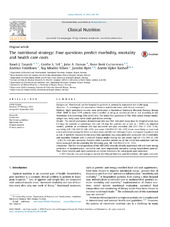| dc.contributor.author | Tangvik, Randi Julie | en_US |
| dc.contributor.author | Tell, Grethe Seppola | en_US |
| dc.contributor.author | Eisman, John A. | en_US |
| dc.contributor.author | Guttormsen, Anne Berit | en_US |
| dc.contributor.author | Henriksen, Andreas | en_US |
| dc.contributor.author | Nilsen, Roy Miodini | en_US |
| dc.contributor.author | Øyen, Jannike | en_US |
| dc.contributor.author | Ranhoff, Anette Hylen | en_US |
| dc.date.accessioned | 2015-03-17T14:11:59Z | |
| dc.date.available | 2015-03-17T14:11:59Z | |
| dc.date.issued | 2014-08 | eng |
| dc.identifier.issn | 0261-5614 | |
| dc.identifier.uri | https://hdl.handle.net/1956/9558 | |
| dc.description.abstract | Background Nutritional care for hospital in-patients is potentially important but challenging. Objective To investigate the association between nutritional status and clinical outcomes. Methods Eight prevalence surveys were performed at Haukeland University Hospital, Norway, during 2008–2009. In total 3279 patients were classified as being at nutritional risk or not according to the Nutritional Risk Screening (NRS 2002) tool. The initial four questions of NRS 2002 assess dietary intake, weight loss, body mass index (BMI) and illness severity. Results The overall prevalence of nutritional risk was 29%. Adjusted mean days for hospitalisation was 8.3 days for patients at nutritional risk and 5.0 days for patients not at risk (p < 0.001). In adjusted models, patients at nutritional risk had increased one-year mortality (OR 4.07, 95% CI 2.90–5.70), morbidity (OR 1.59, 95% CI 1.18–2.13), and were 1.24 (95% CI 1.16–1.32) times more likely to have had a new admission during the three previous years and the one subsequent year, compared to patients not at risk. A ‘positive’ response to the initial four questions was associated with increased risk of morbidity and mortality. Patients with a reduced dietary intake during the last weeks had OR 1.72 (95% CI 1.03–2.85) for one-year mortality. Patients with a positive answer on all the initial four questions had ten times increased risk for mortality the following year, OR 13.0 (95% CI 4.52–37.6). Conclusion The four initial questions of the NRS 2002 robustly identify nutritional risk and were strong predictors of hospitalisation, morbidity and most importantly mortality among hospitalised patients. Thus, these simpler and short questions are robust indicators for subsequent poor outcomes. | en_US |
| dc.language.iso | eng | eng |
| dc.publisher | Elsevier | eng |
| dc.relation.ispartof | <a href="http://hdl.handle.net/1956/10102" target="blank">Nutritional risk in a university hospital. Challenges and consequences in clinical practice</a> | |
| dc.rights | Attribution-NonCommercial-NoDerivs CC BY-NC-ND | eng |
| dc.rights.uri | http://creativecommons.org/licenses/by-nc-nd/3.0/ | eng |
| dc.subject | Implement | eng |
| dc.subject | Nutritional guidelines | eng |
| dc.subject | Nutritional risk | eng |
| dc.subject | Clinical outcome | eng |
| dc.subject | Clinical predictor | eng |
| dc.title | The nutritional strategy: four questions predict morbidity, mortality and health care costs | en_US |
| dc.type | Peer reviewed | |
| dc.type | Journal article | |
| dc.date.updated | 2015-03-04T10:15:51Z | en_US |
| dc.description.version | publishedVersion | en_US |
| dc.rights.holder | Copyright 2013 Elsevier Ltd and European Society for Clinical Nutrition and Metabolism. Published Open Access with the CC-BY-NC-ND license by Elsevier. | |
| dc.identifier.doi | https://doi.org/10.1016/j.clnu.2013.09.008 | |
| dc.identifier.cristin | 1112700 | |
| dc.source.journal | Clinical Nutrition | |
| dc.source.40 | 33 | |
| dc.source.14 | 4 | |
| dc.source.pagenumber | 634-641 | |
| dc.subject.nsi | VDP::Medical sciences: 700::Health sciences: 800::Nutrition: 811 | eng |
| dc.subject.nsi | VDP::Medisinske fag: 700::Helsefag: 800::Ernæring: 811 | nob |

